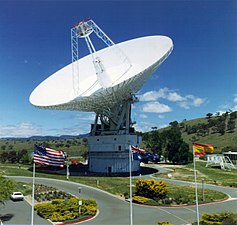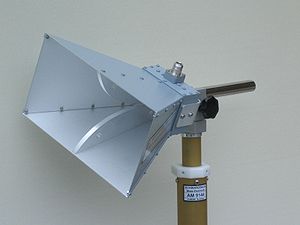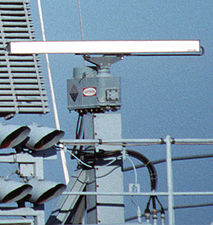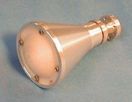Antenna Types – Aperture Antenna
February 3, 2019
Antenna Types – Aperture Antenna

NASA Cassegrain parabolic spacecraft communication antenna, Australia. Uses X band, 8 – 12 GHz. Extremely high gain ~70 dBi.

Microwave horn antenna bandwidth 0.8–18 GHz

X band marine radar slot antenna on ship, 8 – 12 GHz.

Dielectric lens antenna used in millimeter wave radio telescope
Aperture antennas are the main type of directional antennas used at microwave frequencies and above. They consist of a small dipole or loop feed antenna inside a three-dimensional guiding structure large compared to a wavelength, with an aperture to emit the radio waves. Since the antenna structure itself is nonresonant they can be used over a wide frequency range by replacing or tuning the feed antenna.
Parabolic – The most widely used high gain antenna at microwave frequencies and above. Consists of a dish-shaped metal parabolic reflector with a feed antenna at the focus. It can have some of the highest gains of any antenna type, up to 60 dBi, but the dish must be large compared to a wavelength. Used for radar antennas, point-to-point data links, satellite communication, and radio telescopes
Horn – a simple antenna with moderate gain of 15 to 25 dBi that consists of a flaring metal horn attached to a waveguide. Used for applications such as radar guns, radiometers and as feed antennas for parabolic dishes.
Slot – consists of a waveguide with one or more slots cut in it to emit the microwaves. Linear slot antennas emit narrow fan-shaped beams. Used as UHF broadcast antennas and marine radar antennas.
Lens – a lens antenna consists of layer of dielectric or a metal screen or multiple waveguide structure of varying thickness in front of a feed antenna, which acts as a lens which refracts the radio waves, focusing them on the feed antenna.
Dielectric resonator – consists of small ball or puck-shaped piece of dielectric material excited by aperture in waveguide Used at millimeter wave frequencies
